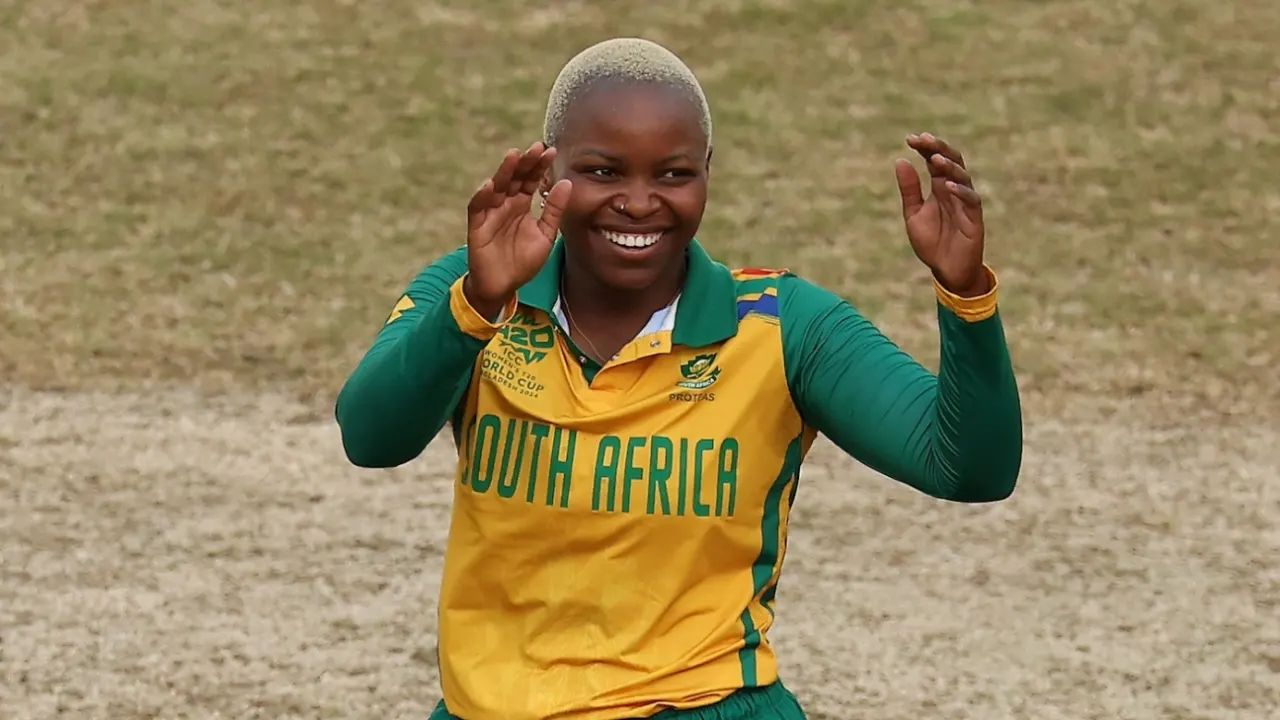Latest News
Kapp sets the tone before bowlers combine in South Africa’s NRR-boosting win over Scotland

South Africa’s openers put on 64, a middle order led by Marizanne Kapp thrashed 70 off the last eight overs, and South Africa motored to 166 for 5, the highest total of the tournament.
Scotland’s reply was in tatters in the first seven overs. They lost both openers for single figures, captain Katherine Bryce was out inside the powerplay, before Alisa Lister and Priyanaz Chaterji departed soon after. They were soon 45 for 6 at the start of the ninth over, and continued to collapse, sliding eventually to 86 all out in the 18th.
South Africa’s left-arm spinners were the prime destroyers. Chloe Tryon was the first to strike, dismissing the Bryce sisters – Katherine and Sarah – caught-and-bowled in successive overs. Nonkululeko Mlaba was a menace through the middle overs, as she has been all tournament, and collected the game’s best figures of 3 for 12 from her four overs, with Nadin de Klerk also getting two wickets in addition to Tryon. Thus, the 80-run victory pushed South Africa to the top of Group B, their net run rate rising to 1.317.
For the second time in three matches, South Africa’s openers were outstanding in the early going (they’d also put on an unbeaten 119 together against West Indies). Wolvaardt had given an early chance, slapping a full toss straight to Katherine Fraser at mid-off, only to be dropped on 2.
She took full toll of the mistake, hitting three fours and a six off the next 13 balls she faced. With Tazmin Brits also joining the boundary-frenzy in the sixth over, South Africa sped to 60 for no loss by the end of the powerplay.
Kapp arrived at the start of the 12th over, and quickly began to dominate. Her first two boundaries came from drives through cover, and then long-off against legspinner Abtaha Maqsood. Then she settled into a rhythm of singles to the leg side, with the occasional lapped sweep with the short fine leg inside the circle. Kapp holed out against the bowling of Katherine Bryce in the 18th over, but she had cracked 43 off 24 balls – the best knock of the game.
Brief scores:
South Africa Women 166 for 5 in 20 overs (Laura Wolvaardt 40, Marizanne Kapp 43, Tazmin Brits 43; Rachel Slater 1-35, Kathryn Bryce 1-35, Olivia Bell 1-34, Katherine Fraser 1-15, Darcey Carter 1-17) beat Scotland Women 86 (Kathryne Fraser 14; Ayaboga Khaka 1-08, Chloe Tryon 2-22, Nonkululeko Mlaba 3-12, Nadine de Klerk 2-15, Annerie Dercksen 1-05) by 80 runs
[Cricinfo]
Latest News
US House votes to avert government shutdown

The Republican-controlled House of Representatives has voted to pass a budget deal to avert what would be the first US federal government shut down since 2019.
The deal, which passed by a vote of 366 -34 only six hours before a midnight deadline, must still be approved by the Democratic-controlled Senate before it can be signed into law by President Joe Biden.
Lawmakers earlier this week had successfully negotiated a deal to fund government agencies – but it fell apart after President-elect Donald Trump and tech billionaire Elon Musk called on Republicans to reject it.
This vote was the third attempt this week to get a deal through the House after a second funding measure – that one backed by Trump – failed on Thursday.
The 118-page “American Relief Act, 2025” that passed in the House on Friday strips out a debt-limit provision that Trump had demanded, which was a sticking point for Democrats and some Republican budget hawks in an earlier draft bill.
The deal also removes measures sought by Democrats in the first version of the bill, including the first pay raise for lawmakers since 2009, federal funds to rebuild a bridge that collapsed in Baltimore, healthcare reforms, and provisions aimed at preventing hotels and live event venues from deceptive advertising.
A total of 34 Republicans voted against the short-term funding bill while all Democrats in attendance were in favour.
Trump has not yet commented on the vote. A statement put out by the White House on behalf of Biden praises the deal.
Ahead of the vote, Democrats slammed the involvement of Mr Musk in the process, who they pointed out is an unelected billionaire.
Mr Musk, who Trump has tasked with cutting government spending in his future administration, had lobbied heavily against an earlier bill.
During floor debate, Republicans said they look forward to a “new era” when Trump takes office and Republicans take control of both chambers of Congress next month.
The wrangling over budget left Republican House Speaker Mike Johnson bruised amid criticism from members of his own party over his handling of the process.
“We are grateful that everyone stood together to do the right thing and having gotten this done now as the last order of business for the year, we are set up for a big and important new start in January,” Johnson told reporters after Friday’s vote.
He also said that he had spoken frequently to both Trump and Mr Musk during the negotiations.
Johnsons remarks came shortly after Mr Musk praised the Louisiana congressman’s work on the budget in a post on X, the social media platform he owns.
“The Speaker did a good job here, given the circumstances,” he posted. “It went from a bill that weighed pounds to a bill that weighed ounces.”
The dramatic budget fight served as a preview of the tense legislative fights that could be in store next year, once Trump is in the White House.
Officials have warned that if there is no funding deal going into the holiday season, millions of federal employees would go without paycheques if the government shuts down.
There will be countless other ways a shut down would affect Americans – including by limiting assistance to aid-reliant farmers and people recovering from natural disasters.
The last government shutdown was during Trump’s first term in 2019 after the Republican-controlled House of Representatives failed to come to an agreement on a new spending bill.
That shutdown lasted 35 days, and was the longest in US history.
[BBC]
Latest News
Australia call-up Konstas, 19, for Boxing Day Test

Australia have dropped Nathan McSweeney and called up 19-year-old opener Sam Konstas to replace him for the final two Tests against India.
New South Wales’ Konstas is in line to become Australia men’s youngest Test batting debutant since Ian Craig in 1953.
McSweeney was preferred to Konstas at the start of the series but he managed only 72 runs across six innings at an average of 14.40.
Australia’s chief selector George Bailey said Konstas’ selection offers the chance to “throw something different” at India’s bowling attack.
“I think Sam’s method and style is different to Nathan’s, should we go down that path,” he said.
Earlier this season Konstas scored two centuries against South Australia in the Sheffield Shield, becoming the youngest player to do so since Ricky Ponting in 1993.
Should the right-hander be picked, he would become Australia’s youngest Test debutant since current skipper Pat Cummins, who was 18 years and 193 days when he played against South Africa in 2011.
Seamer Jhye Richardson, who last played a Test in the 2021-22 Ashes, has also been recalled with Josh Hazlewood out injured.
Fellow quick Sean Abbott and all-rounder Beau Webster, both uncapped at Test level, have been retained in the squad, having been called up previously in the series but not selected in the XI.
Usman Khawaja and Marnus Labuschagne, who, like McSweeney, have struggled at the top of the order, have retained their places in the squad.
The Boxing Day Test in Melbourne starts at 23:30 GMT on 25 December with the series tied at 1-1.
Australia squad for final two Tests v India: Pat Cummins (captain), Travis Head, Steve Smith, Sean Abbott, Scott Boland, Alex Carey, Josh Inglis, Usman Khawaja, Sam Konstas, Marnus Labuschagne, Nathan Lyon, Mitchell Marsh, Jhye Richardson, Mitchell Starc, Beau Webster
[BBC]
Latest News
Swimming mouse among 27 new species discovered in Peru

An amphibious mouse with webbed feet and a blob-headed fish are among 27 new species scientists have discovered in Peru.
They were found in an expedition to Alto Mayo – which includes the Amazon rainforest – by scientists from the non-profit organisation Conservation International and members of local indigenous groups.
Up to 48 other new species may also have been found, although further study will be needed to determine whether they are new, Conservation International says.
“Discovering so many new species of mammals and vertebrates is really incredible, especially in such a human-influenced landscape,” said Trond Larsen, senior director at Conservation International
Alto Mayo is a protected area in northern Peru with multiple ecosystems and Indigenous territories.
It has a relatively high population density, putting pressure on environmentalism through deforestation and agricultural expansion, Conservation International said.
Yulisa Tuwi, an Awajún woman who assisted with the research, said the report “allows the Awajún to protect our culture, natural resources and our territory”, as it gives them a better understanding of the ecosystems.
“The Awajún have extensive traditional knowledge about the forests, animals and plants they live side-by-side with,” Mr Larsen said.
The expedition also found a new species of dwarf squirrel. eight types of fish, three amphibians and 10 types of butterfly.

This “blob-headed” fish is a new discovery to science, but the Indigenous Awajún people who helped with the expedition were already aware of its existence.
The fish scientists were particularly shocked by its enlarged head – something they had never seen before.Ronald Diaz/ Conservation International
A new species of dwarf squirrel will also belong to a new genus, giving it a higher level of distinction
This dwarf squirrel measures just 14cm (5.5in), half the length of an average grey squirrel in the UK, which ranges from 24 to 29cm, according to the UK Squirrel Accord.
“It fits so easily in the palm of your hand. Adorable and beautiful chestnut-brown colour, very fast,” Larsen said. “It jumps quickly and hides in the trees.”

Scientists discovered a new species of spiny mouse – named after the especially stiff guard hairs found on their coats, which function similar to the spines of a hedgehog.
They also found a new “amphibious mouse”, which has partially webbed feet and eats aquatic insects.
It belongs to a group of semi-aquatic rodents considered to be among the rarest in the world, with the few species known to exist only spotted a handful of times by scientists.



(BBC)
-

 Opinion6 days ago
Opinion6 days agoDegree is not a title!
-

 Features7 days ago
Features7 days agoSpiritual Awakening of a Village
-

 News4 days ago
News4 days agoInnovative water management techniques revolutionising paddy cultivation in Lanka
-

 Features6 days ago
Features6 days agoRevisiting the role of education in shaping shared futures
-

 Features3 days ago
Features3 days agoThe Degree Circus
-

 Features7 days ago
Features7 days agoThe Silence of the Speaker and other matters
-

 Editorial6 days ago
Editorial6 days ago‘Compass’ under the microscope
-

 Editorial7 days ago
Editorial7 days agoPerks and privileges











